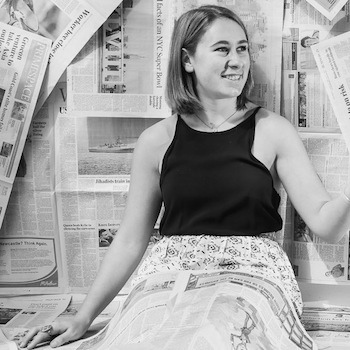Surge in media studies: Digital mobility creates wave of new career opportunities

Media student Sharmonie Cockayne
Mass media is undergoing massive change with the rapid spread of digital technologies and mobile devices.
Not since the introduction of radio and television has the media landscape altered so significantly - and for young people entering the industry the opportunities have never been greater. To ensure its students are prepared for this dynamic communications era, the University of Adelaide has restructured its media degree with various new study options - and enrolments are surging as a result. First preference applications jumped by 25 per cent at the start of 2014 and this has translated into a substantial increase in students enrolled in the different streams. Dr Kathryn Bowd joined the University in mid-2013 as a Senior Lecturer and is part of an expanding team of media educators recruited to deliver the new program. A journalist for 17 years in Australia and the UK, Dr Bowd became a fulltime media lecturer and researcher in 2000 and has experienced first-hand the impact of new technologies on media delivery and consumption. She says changes in the way people access news are among the most dramatic. "Students joining our courses are all familiar with social media, but they don't necessarily engage in the same way with traditional media such as newspapers or television news," she says. "People no longer have to sit down at a particular time every day to watch the TV news - they do it when and where it suits them. "The fact that media is so much more mobile and immediately accessible is one of the big changes. It's a real challenge for the business model of journalism and also the media more generally." The University's restructured Media degree is designed to reflect these changes with the introduction of three majors offered as part of the new program. Students now have a choice of doing the degree at a broad-based level plus the option of choosing from one of three majors: journalism, marketing or media production. Production is run in partnership with the Creative Industries Centre at Tea Tree Gully TAFE, with students able to specialise in computer-generated imagery (CGI) and visual effects, game art, digital production, photographic imaging or graphic design. There is a strong technology focus in the degree, an area which Dr Bowd says is changing all the time. "That's one of the real challenges of teaching and researching in this area - keeping on top of all the nuts and bolts of the new technology," she says. "From a teaching perspective it's about the big picture and how to apply this technology, because students will always be at the leading edge of accessing it." And while technology continues to transform the media environment, Dr Bowd is regularly asked by students about the future of mainstream journalism. Her response is upbeat. "Certainly there are fewer jobs in mainstream journalism than there were a few years ago, but on the positive side, media and communications more broadly is a hugely growing area," she says. "Today there are opportunities that didn't exist a few years ago and for people starting their degrees there will be opportunities tomorrow that don't exist now." Dr Bowd also says the fundamental principles of journalism - gathering and distributing news to an audience - have not changed. It's just that people want to know about it immediately, no matter where they are. In such a vibrant and instant media environment, traditional printed newspapers are facing some major challenges, but they appear to be retaining their central place in information networks in regional communities. Like many journalists, Dr Bowd began her career in country newspapers. Their place in modern media was the theme of her PhD research project and continues to be a focus for her current studies. "Interestingly, regional news media have a very different place in communities to metropolitan media," she says. "We tend to think of newspapers as being on the way out, and they may be in the traditional printed form, but in regional areas they are still doing relatively well. "There are many reasons, but a key one is their social context and their importance to the local community." Dr Bowd is currently examining how newspaper journalists make use of social media in their work and how their approaches differ in regional and metropolitan areas.
|




